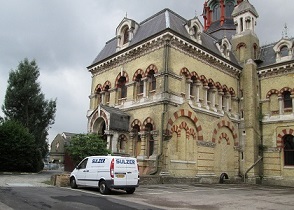The UK's Lee Tunnel project will increase storm water storage and prevent it from spilling into a local river. The project also includes the refurbishment of the Abbey Mills pumping station, a task undertaken by pump manufacturers, Sulzer.
The original Abbey Mills A pumping station is a Grade II listed building, built between 1865 and 1868, and its ornate pumping equipment is Grade I listed. Following the commissioning of the Abbey Mills F pumping station in 1998, the older station was re-designated as a standby storm pumping station.
Station A at Abbey Mills acts as backup to Station F to assist with exceptional storm flows and, as such, must have fully operational and efficient pumping equipment in order to accomplish this role. In total there are eight pumps, originally designed in 1933 and powered by 600 HP, 2.2 kV, 28 pole motors. As part of the ongoing maintenance of the site, these pumps, the motors and control gear have been refurbished by Thames Water.
Thames Water is currently upgrading the entire London sewerage system to cope with the expanding population and improve the water quality of the River Thames. The Lee Tunnel project involves the construction of a new tunnel which measures 6.9 km in length and 7.2 m internal diameter which will provide approximately 382,000 m3 of storage, and deliver it to Britain's largest sewage treatment works at Beckton.
Thames Water had previously asked Sulzer to overhaul five of the W.H. Allen 48 inch pumps at the station as part of a series of previous projects and on this latest project Sulzer has refurbished the remaining three pumps. Working withother contractors responsible for the replacement of the motors and gearboxes, Sulzer engineers coordinated their operation to ensure the project was completed successfully.

The original Abbey Mills A pumping station is a Grade II listed building, built between 1865 and 1868.
Chris Powles, managing director for Rotating Equipment Services in the UK, said: “The project has presented a number of challenges in terms of component design and operating in a working museum. It has been essential to preserve the historical importance of the site while also designing and installing modern and more efficient components that will significantly prolong the operational life of the station.”
When the first pumps were refurbished in 2005, Sulzer addressed a number of design issues and introduced a new intermediate shaft made from carbon fibre and, in addition, redesigned the bearing arrangement. Improvements were also made to the stuffing box bush arrangement and a new carbon steel impeller was installed to increase service life and simplify future repairs.
The design and manufacturing work was completed at Sulzer's Leeds Service Centre and included the introduction of a split mechanical seal to replace the gland packing for improved reliability and reduced maintenance requirements. This was installed with a bespoke seal flushing system that is connected to each of the pump units and is essential to ensure that the mechanical seals perform reliably. In addition, the re-designed thrust bearing arrangement is designed to save around 5 kW of absorbed pumped power as well as increasing the mean time between failure (MTBF).

The re-designed thrust bearing arrangement is designed to save around 5 kW of absorbed pumped power as well as increasing the mean time between failure (MTBF).

The outward appearance of the pump unit is very similar to the original and very much in keeping with the historic appearance of the equipment within the Abbey Mills station.
The outward appearance of the pump unit is very similar to the original and very much in keeping with the historic appearance of the equipment within the Abbey Mills station. Meanwhile the internal components have been designed to deliver improved reliability using more standard parts that simplify maintenance requirements and minimise any repair times.
The project has been completed to Water Industry Mechanical and Electrical Specifications (WIMES) as per Thames Water requirements and the design improvements that were initially installed in 2005 have now been applied to all eight pumps. The on-site work and actual pump refurbishment was completed by Sulzer's Ashford Service Centre, which has operated as the single point of contact throughout the various projects undertaken at Abbey Mills.
Chris Powles concluded: “Engineers from the local service centre coordinated their work to remove and reinstall the pumps with the other contractors and with Thames Water, who needed to keep the pumping station operational throughout the project. As a result of this and the previous projects, the historic Abbey Mills pumping station will be able to continue its supporting role for many years to come.”





